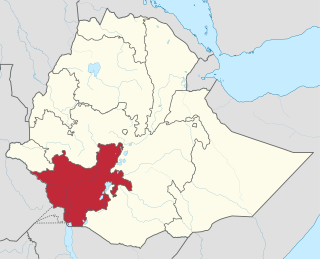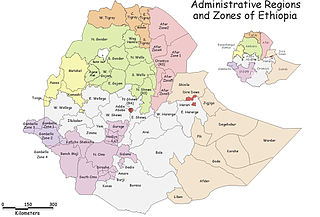Demographics
Based on the 2007 Census conducted by the Central Statistical Agency of Ethiopia (CSA), this zone has a total population of 90,846, of whom 44,686 are men and 46,160 women. With an area of 2,381.63 square kilometers, Konta has a population density of 38.14; 8,257 or 9.09% are urban inhabitants. A total of 21,854 households were counted in this woreda, which results in an average of 4.16 persons to a household, and 21,114 housing units. The five largest ethnic groups reported in Konta were the Konta (85.52%), the Chara (4.07%), the Wolayta (3.75%), the Kaffa (2.19%), and the Amhara (1.13%); all other ethnic groups made up 3.34% of the population. Konta is spoken as a first language by 83.39%, 4.21% Kafa, 4.07% Chara, 3.73% Wolaytta, and 1.12% speak Amharic; the remaining 3.48% spoke all other primary languages reported. 49.11% were Protestants, 43.7% of the population said they were Ethiopian Orthodox Christianity, and 4.72% practiced traditional beliefs. [5]
The 1994 national census reported a total population for this zone of 52,321 of whom 25,284 were males and 27,037 were females; 2,787 or 5.33% of its population were urban dwellers. The three largest ethnic groups reported in Konta were the Konta (86.19%), the Kaffa (5.37%), and the Chara (3.25%); all other ethnic groups made up 5.19% of the population. Konta is spoken as a first language by 85.14%, 6.71% Kafa, and 3.28% speak Chara; the remaining 4.87% spoke all other primary languages reported. [6] However, Ralph Siebert's local research in 1995 led him to believe that this zone was predominantly inhabited by the Dawro people. [7] Concerning religious beliefs, the 1994 census reported that 44.55% of the population said they observed traditional religions, 43.19% practiced Ethiopian Orthodox Christianity, and 7.53% were Protestants. [6]

The Southern Nations, Nationalities, and Peoples' Region was a regional state in southwestern Ethiopia. It was formed from the merger of five kililoch, called Regions 7 to 11, following the regional council elections on 21 June 1992. Its government was based in Hawassa.

Bench Sheko is a zone in the South West Ethiopia Peoples' Region of Ethiopia. Bench Sheko is bordered on the south and southeast by West Omo, on the west by the Gambela Region on the north by Sheka, and on the east by Keffa. The administrative center of Bench Sheko is Mizan Teferi.

South Omo Zone is a zone in the Ethiopian South Ethiopia Regional State. South Omo is bordered to the south by Kenya, to the southwest by the South Sudan, to the west by Bench Maji, to the northwest by Keffa, to the north by Konta, Gamo Gofa and Basketo, to the northeast by Dirashe and Konso and to the east by the Oromia Region. The administrative center of South Omo is Jinka.

Keficho Shekicho was a zone in the Southern Nations, Nationalities, and Peoples' Region of Ethiopia. A 1997 Situation Report by the United Nations Development Programme/Emergencies Unit for Ethiopia states that originally Kaffa and Sheka were separate zones, but were combined in early 1996. Keficho Shekicho was later separated for Keffa and Sheka Zones.

Kembata is a zone in the Central Ethiopia Regional State of Ethiopia. It was formerly known as Kembata, Alaba and Tembaro, until Alaba and Tembaro became a special woreda in 2002 and 2023 respectively. This zone is named after the Kambaata people which gained zonal posture following the establishment of Central Ethiopian region in 2023.

North Omo Zone was a zone in the Southern Nations, Nationalities, and Peoples' Region of Ethiopia. It was named after the Omo River, which flows in the western area of the former zone. In 2000 it was split into three zones: Dawro, Gamo Gofa, and Wolayita; and Basketo and Konta became special woredas.

Konso is a zone in the South Ethiopia Regional State, Ethiopia. It was formerly a woreda. Prior to 2011, Konso was not part of any Zone in the Southern Nations, Nationalities and Peoples' Region (SNNPR) and was therefore considered a special woreda, an administrative subdivision which is similar to an autonomous area. In 2011, the Segen Area Peoples Zone was established, which includes Konso special woreda and the 3 former woredas surrounding it. This special woreda is named after the Konso people. Located in the Great Rift Valley, Konso is bordered on the south by the Oromia Region, on the west by the South Omo Zone, on the northwest by Alle special woreda, on the north by Dirashe special woreda, on the northeast by Amaro special woreda, and on the east by Burji special woreda. The Sagan River, which flows south then west to join the Weito, defines part of the woreda's boundary with Burji and the entire length of the boundary with the Oromia Region. The administrative center is Karati; other towns in Konso include Fasha and Sagen. After protesting by residents to become a zone for several years, Konso became a zone in November 2018.
Kuraz is one of the woredas in the Southern Nations, Nationalities, and Peoples' Region of Ethiopia. It is the homeland of Daasanach people. Part of the Debub Omo Zone, Kuraz is bordered on the south by Kenya, on the west by the Ilemi Triangle, on the north by Nyangatom, and on the east by Hamer. The Omo River is flowing through Kuraz to Lake Turkana at the border of Kenya. The administrative center of this woreda is Omorate. Nyangatom woreda was separated from Kuraz.
Damot Gale is a woreda in South Ethiopia Regional State, Ethiopia. Part of the Wolayita Zone, Damot Gale is bordered on the southwest by Sodo Zuria, on the northwest by Boloso Sore and Damot Pulasa, on the north by the Hadiya Zone, on the east by Diguna Fango, and on the southeast by Damot Weyde. The administrative center of Damot Gale is Boditi. Damot Pulasa woreda was separated from Damot Gale.
Decha is a district in the South West Region of Ethiopia. The name Decha comes from one of the provinces in the former Kingdom of Kaffa, which had the approximately same boundaries. Part of the Keffa Zone, Decha is bordered on the south by the Omo River which separates it from the Debub Omo Zone, on the west by the Bench Maji Zone, on the northwest by Chena, on the north by Ginbo, on the northeast by Menjiwo, on the west by Telo and Cheta, and on the southeast by the Denchya River which separates it from the Konta special district. The major town in Decha is Chiri.
Menjiwo is a district in the South West Region of Ethiopia. The name Menjiwo is derived from the province Manjo of the Kingdom of Kaffa; however, the province of Manjo lay within the boundaries of neighboring Ginbo, while Menjiwo occupies the lands of the Gallo province of the former kingdom. Part of the Keffa Zone, Menjiwo is bordered on the south by Telo, on the southwest by Decha, on the west by Ginbo, on the north by the Gojeb River which separates it from the Oromia Region, and on the east by the Konta special district. The major town in Menjiwo is Adiya Kaka.
Isara Tocha was one of the 77 woredas in the Southern Nations, Nationalities, and Peoples' Region of Ethiopia. Part of the Dawro Zone, Isara Tocha was bordered on the south by the Omo River which separates this woreda from the Gamo Gofa Zone, on the west by the Konta special woreda, on the north by the Gojeb River which separates it from the Oromia Region, on the east by Mareka Gena, and on the southeast by Loma Bosa. Towns in Isara Tocha included Bale and Tocha. Isara Tocha was separated to Isara and Tocha woredas.

Basketo Zone is a zone in the South Ethiopia Regional State of Ethiopia, named after its inhabitants, the Basketo people. It was formerly a part of the Southern Nations, Nationalities and Peoples' Region (SNNPR)'s, and because Basketo was not part of any administrative Zone in the SNNPR, it was considered a special woreda—an administrative subdivision which is similar to an autonomous area.
Gofa Zone is a zone in the South Ethiopia Regional State of Ethiopia. It was previously one of the 17 Zones in the Southern Nations, Nationalities, and Peoples' Region (SNNPR) of Ethiopia. Within the SNNPR, Gofa Zone was bordered to the south by Kamba and Daramalo woredas, to the southwest by the Debub (South) Omo Zone, to the west by the Basketo special woreda, to the northwest by Dawro Zone, to the north by the Dawro Zone, and to the east by Kucha. The administrative center of Gofa Zone is Sawla; other towns included Bulki. Gofa Zone was separated for Demba Gofa Woreda, Geze Gofa Woreda, Zala Woreda, Malo Koza Woreda, Gada Woreda, Uba Debretsehay Woreda, Oyda Woreda and the two town Administrations Sawla town and Bulki town.
Kemba is one of the woredas in the Southern Nations, Nationalities, and Peoples' Region of Ethiopia. Part of the Gamo Gofa Zone, Kemba is bordered on the southwest by the Debub Omo Zone, on the west by Uba Debretsehay, on the northwest by Zala, on the northeast by Deramalo, on the east by Bonke, and on the southeast by the Dirashe special woreda; the Weito River defines the boundary with Bonke and Dirashe. The major town in this woreda is Kemba.
Selamago is a woreda in the Southern Nations, Nationalities, and Peoples' Region of Ethiopia. Part of the Debub Omo Zone, Selamago is bordered on the south by Nyangatom, on the west and north by the Omo River which separates it from the Bench Maji, Keffa and Konta, on the northeast by the Gamo Gofa, on the east by the Basketo and Bako Gazer, and on the southeast by the Usno River which separates it from Bena Tsemay; the Mago River defines part of the boundary with Bako Gazer. The administrative center of Selamago is Hana.
Melokoza is one of the woredas in the Southern Nations, Nationalities, and Peoples' Region of Ethiopia. Part of the Gamo Gofa Zone, Melokoza is bordered on the south by Basketo special woreda, on the southwest by the Debub (South) Omo Zone, on the northwest by the Konta special woreda, on the north by the Dawro Zone, and on the east by Demba Gofa and Geze Gofa; the Omo River defines its northwestern boundary separating the woreda from Konta and the Dawro Zone. The major town in Melokoza is Leha.
Gamo Zone is a zone in the South Ethiopia Regional State of Ethiopia. Gamo is bordered on the south by the Dirashe special woreda, on the southwest by Debub (South) Omo and the Basketo special woreda, on the northwest by Konta special woreda, on the north by Dawro and Wolayita, on the northeast by the Lake Abaya which separates it from the Oromia Region, and on the southeast by the Amaro special woreda. The administrative center of Gamo is Arba Minch.

Dawro is a zone in the South West Region of Ethiopia. The name "Dawuro" represents both the land and the people. It is located at about 500km southwest of Addis Ababa, the capital of Ethiopia and 319 km of Hawassa, the capital of the Sidama Region. Dawuro is bordered on the south by Kucha in Gamo Zone, on the west by the Konta Zone, on the north by the Gojeb River which defines its boundary with the Oromia Region,Jimma zone, on the northeast by Hadiya and Tembaro Special Woreda in Central Ethiopia Regional State, and on the east by Wolayita Zone; the Omo River defines its eastern and southern boundaries.
Keffa or Kaffa, is a zone in the South West Region of Ethiopia. The administrative center is Bonga.



